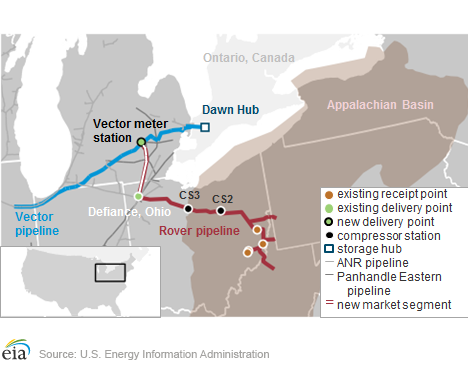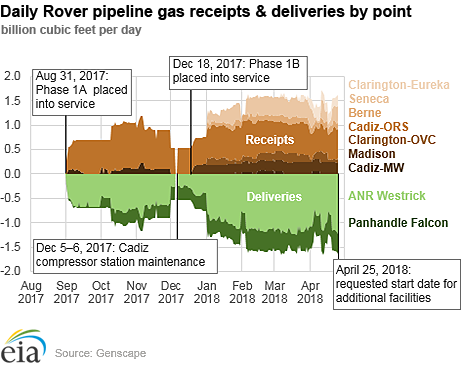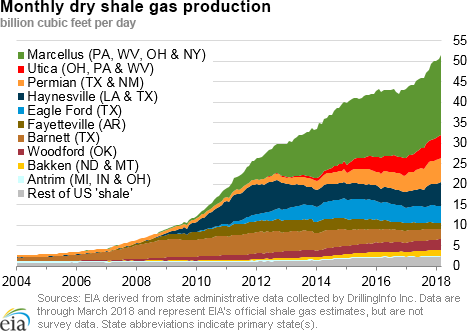In the News:
FERC authorizes Rover Pipeline, LLC to place additional facilities partially in service
On April 25, 2018, the Federal Energy Regulatory Commission (FERC) approved a portion of Rover Pipeline, LLC’s (Rover) April 13 request to place key facilities associated with Phase 2 of the Rover pipeline project into service. In addition to compressor station and mainline facilities, the filing also requested permission to place the Vector meter station in Livingston County, Michigan, into service, as well as the new pipeline market segment connecting that meter station to the Defiance, Ohio, compressor station. While FERC granted approval to Rover to commence service of Compressor Station 3 (CS3) and a portion of the mainline between Compressor Stations 2 (CS2) and CS3, FERC is still evaluating the new market segment, the Defiance, Ohio compressor station, and the Vector meter station. These facilities, when completed, will improve the ability to deliver natural gas produced in the Appalachian Basin to Michigan and Canadian markets.
The new facilities will allow delivery of up to 1.45 billion cubic feet per day (Bcf/d) of natural gas produced in the Appalachian Basin to local distribution companies and underground storage fields throughout Michigan as well as to Enbridge’s Dawn storage hub in Ontario, Canada.
Rover is a greenfield interstate natural gas pipeline that is being constructed by Energy Transfer Partners in multiple phases. Phase 1A and Phase 1B were placed into service on August 31, 2017, and December 18, 2017, respectively. Phase 1A and Phase 1B enabled the transportation of natural gas from Carroll County, Ohio, to interconnects on the ANR and Panhandle interstate pipelines near the Midwest Hub in Defiance, Ohio. In the time since Phase 1B went into service, natural gas pipeline flows on Rover to the ANR Westrick and Panhandle Falcon delivery points have averaged an estimated 1.4 Bcf/d of natural gas, or 82%, of the 1.7 Bcf/d capacity.
When construction is complete—currently estimated for the second quarter of 2018—Rover will be capable of delivering up to 3.25 Bcf/d of natural gas, with up to 68% for distribution to markets across the United States via the ANR Westrick and Panhandle Falcon delivery points and the remaining 32% for delivery to Michigan and Ontario, Canada, markets via the Vector pipeline. According to Rover, 83% of the horizontal directional drilling and 99% of the construction for the project are complete.
Rover is one of several pipeline projects intended to increase the takeaway capacity for natural gas produced in the Appalachian Basin. In recent years, many natural gas trading hubs in the Appalachian region have been priced at a discount to the Henry Hub in Louisiana—the U.S. benchmark natural gas price—indicating constraints on the existing pipelines to move natural gas from this production region to wider markets. In total, Energy Transfer Partners has received 2.95 Bcf/d in binding transportation commitments, according to S&P Global Platts. These commitments include long-term (more than 14 years) firm transportation contracts with natural gas producers in the Appalachian Basin that have a total capacity of up to 1.8 Bcf/d.
EIA maintains a database of existing, under construction, and planned interstate and intrastate natural gas pipeline projects. The database includes project names, operators, capacities, in-service dates, affected states, and other details about U.S. natural gas pipeline infrastructure.
Overview:
(For the Week Ending Wednesday, April 25, 2018)
- Natural gas spot prices fell at most locations this report week (Wednesday, April 18 to Wednesday, April 25). The Henry Hub spot price fell from $2.84 per million British thermal units (MMBtu) last Wednesday to $2.79/MMBtu yesterday.
- At the New York Mercantile Exchange (Nymex), the May 2018 contract, which expires today, rose 5¢ from $2.739/MMBtu last Wednesday to $2.786/MMBtu yesterday.
- Net withdrawals from working gas totaled 18 billion cubic feet (Bcf) for the week ending April 20. Working natural gas stocks are 1,281 Bcf, which is 41% lower than the year-ago level and 29% lower than the five-year (2013–17) average for this week.
- The natural gas plant liquids composite price at Mont Belvieu, Texas, rose by 15¢, averaging $7.72/MMBtu for the week ending April 25. The price of natural gasoline, propane, butane, and isobutane rose by 2%, 2%, 4%, and 5%, respectively. The price of ethane remained flat week over week.
- According to Baker Hughes, for the week ending Tuesday, April 17, the natural gas rig count remained flat at 192. The number of oil-directed rigs rose by 5 to 820. The total rig count increased by 5, and it now stands at 1,013.
Prices/Supply/Demand:
Prices fall across most of the Lower 48 states. This report week (Wednesday, April 18 to Wednesday, April 25), the Henry Hub spot price fell 5¢ from $2.84/MMBtu last Wednesday to $2.79/MMBtu yesterday. At the Chicago Citygate, prices decreased 55¢ from their weekly high of $3.16/MMBtu last Wednesday to $2.61/MMBtu yesterday. Prices at PG&E Citygate in Northern California fell 22¢, down from their weekly high of $2.92/MMBtu last Wednesday to $2.70/MMBtu yesterday. The price at SoCal Citygate decreased 13¢ from $3.07/MMBtu last Wednesday to $2.94/MMBtu yesterday, after reaching a weekly high of $4.38 on Monday.
At the Algonquin Citygate, which serves Boston-area consumers, prices went down $5.62 from $8.34/MMBtu last Wednesday to $2.72/MMBtu yesterday. The region started the week with high prices because of cold temperatures and supply constraints on the Algonquin Gas Transmission Pipeline. At the Transcontinental Pipeline Zone 6 trading point for New York City, prices decreased 61¢ from their weekly high of $3.05/MMBtu last Wednesday to $2.44/MMBtu yesterday.
Tennessee Zone 4 Marcellus spot prices decreased 6¢ from $1.99/MMBtu last Wednesday to $1.93/MMBtu yesterday, staying within a 6¢ range all week. Prices at Dominion South in northwest Pennsylvania fell 33¢ from their weekly high of $2.65/MMBtu last Wednesday to $2.32/MMBtu yesterday.
Nymex prices rise. At the Nymex, the price of the May 2018 contract, which expires today, increased 5¢, from $2.739/MMBtu last Wednesday to $2.786/MMBtu yesterday. The price of the 12-month strip averaging May 2018 through April 2019 futures contracts climbed 1¢ to $2.879/MMBtu.
Supply increases. According to data from PointLogic Energy, the average total supply of natural gas rose by 1% compared with the previous report week. Dry natural gas production grew by 1% compared with the previous report week. Average net imports from Canada increased by 2% from last week.
Demand falls as temperatures warm. Total U.S. consumption of natural gas fell by 6% compared with the previous report week, according to data from PointLogic Energy. In the residential and commercial sectors, consumption declined by 14%, as weather was warmer than normal west of the Rocky Mountains and close to normal on the eastern seaboard. Natural gas consumed for both power generation and in the industrial sector declined by 2% week over week. Natural gas exports to Mexico decreased 1%.
U.S. liquefied natural gas (LNG) exports remain flat week over week. Six LNG vessels from Sabine Pass and Dominion Energy Cove Point liquefaction terminals departed the United States from April 19 to April 25. Four vessels (combined LNG-carrying capacity 14.9 Bcf) departed the Sabine Pass liquefaction facility, and one vessel (LNG-carrying capacity 3.5 Bcf) was loading at the terminal on Wednesday, April 25.
Since the start of LNG shipments on March 1, a total of six vessels (combined LNG-carrying capacity 19.9 Bcf) departed Dominion Energy Cove Point liquefaction terminal. Last week, two LNG tankers (combined LNG-carrying capacity 7.5 Bcf) were loaded at the terminal. One of these tankers, LNG Sakura (LNG-carrying capacity 3.9 Bcf), is carrying the first Cove Point LNG export to Japan, according to the shipping data compiled by Bloomberg. This tanker departed the terminal on April 22.
Storage:
Updated May 3, 2018 to fix incorrectly reported years.
Working gas storage continues to post net withdrawals for the third week of the refill season. Net withdrawals from storage totaled 18 Bcf for the week ending April 20, compared with the five-year (2013–17) average net injections of 60 Bcf and last year's net injections of 71 Bcf during the same week. The natural gas storage refill season typically begins on April 1. However, colder-than-normal temperatures throughout most of the Lower 48 states have resulted in continued withdrawals from storage. This week’s report marks the third week in a row—and sixth time since 2010—that net withdrawals from storage on a national level were reported during April. Working gas stocks totaled 1,281 Bcf, which is 527 Bcf lower than the five-year average and 897 Bcf lower than last year at this time.
Continued April withdrawal activity is unprecedented. Net withdrawals from storage total 71 Bcf thus far in April. This is the first time in the history of the Weekly Natural Gas Storage Report, which dates back to 1994, that net withdrwals from storage continued during the first three weeks of April. Working gas stocks have not posted a net decline for the first month of the refill season since 1983 when net withdrawals totaling 74 Bcf were reported. The smallest net monthly injections reported on a monthly basis for April totaled 29 Bcf in 1992. If net injections into working gas match the five-year average of 101 Bcf for the remainder of April, then the net injections for the month will total 30 Bcf.
This week’s net change included withdrawals from base gas for the third week in row. Withdrawals from base gas were reported to EIA for the storage week. The cumulative net withdrawals of base gas were treated as negative working gas stocks and were reflected in the working gas inventories reported in the Weekly Natural Gas Storage Report (WNGSR). The aggregate effect of these withdrawals from base gas remain lower than the 4 Bcf threshold for reporting reclassifications of working gas. These withdrawals from base gas are expected to be temporary, and these storage operators likely will replenish their base gas as the refill season progresses. EIA will continue to report on these volumes until base gas is replenished.
The average May 2018 futures contract price trades at a discount to the average weekly spot price. During the most recent storage week, the average natural gas spot price at the Henry Hub was $2.81/MMBtu, 9¢/MMBtu higher than the front-month futures price at the Nymex. This pricing pattern provided economic incentives to withdraw natural gas from storage to avoid exposure to the spot market. A year ago, the spot price was 12¢ lower than the front-month contract.
Reported net withdrawals from storage is outside of the range of most analysts’ expectations. According to the Desk survey of natural gas analysts, estimates of the weekly net change from working natural gas storage ranged from net withdrawals of 25 Bcf to net injections of 2 Bcf with a median of -13 Bcf.
Temperatures were moderate, but remain colder than normal, across the eastern United States and Midwest during the storage week. Temperatures in the Lower 48 states averaged 49 degrees Fahrenheit (°F), 4°F lower than the normal and 11°F lower than last year at this time. Temperatures in the heavy natural gas-consuming areas of the Midwest and East regions posted significantly colder-than-normal temperatures. The average temperature for the Lower 48 states was 3°F higher than during the prior storage week.
See also:
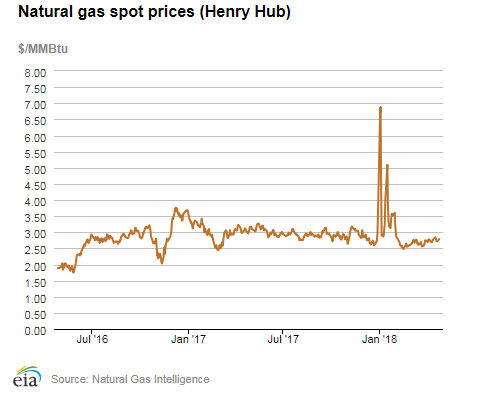
| Spot Prices ($/MMBtu) | Thu, 19-Apr |
Fri, 20-Apr |
Mon, 23-Apr |
Tue, 24-Apr |
Wed, 25-Apr |
|---|---|---|---|---|---|
| Henry Hub |
2.77 |
2.72 |
2.74 |
2.77 |
2.79 |
| New York |
2.82 |
2.75 |
2.71 |
2.65 |
2.44 |
| Chicago |
2.71 |
2.54 |
2.61 |
2.64 |
2.61 |
| Cal. Comp. Avg.* |
2.19 |
2.10 |
2.24 |
2.35 |
2.29 |
| Futures ($/MMBtu) | |||||
| May contract | 2.660 |
2.739 |
2.740 |
2.781 |
2.786 |
| June contract |
2.695 |
2.767 |
2.775 |
2.813 |
2.807 |
| *Avg. of NGI's reported prices for: Malin, PG&E Citygate, and Southern California Border Avg. | |||||
| Source: NGI's Daily Gas Price Index | |||||
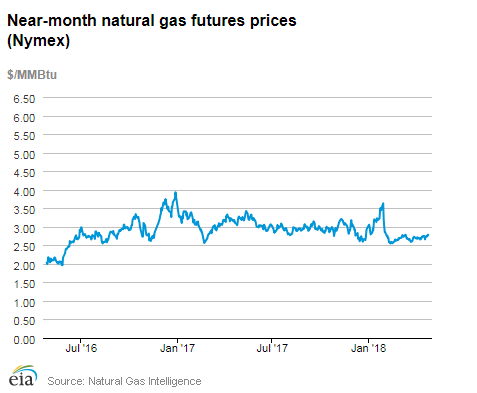
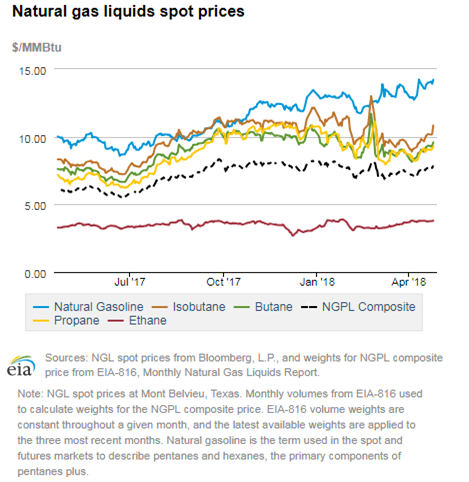
| U.S. natural gas supply - Gas Week: (4/19/18 - 4/25/18) | |||
|---|---|---|---|
Average daily values (Bcf/d): |
|||
this week |
last week |
last year |
|
| Marketed production | 90.7 |
90.1 |
80.3 |
| Dry production | 80.1 |
79.6 |
71.2 |
| Net Canada imports | 5.8 |
5.7 |
5.1 |
| LNG pipeline deliveries | 0.1 |
0.1 |
0.1 |
| Total supply | 86.0 |
85.3 |
76.3 |
|
Source: OPIS PointLogic Energy, an IHS Company | |||
| U.S. natural gas consumption - Gas Week: (4/19/18 - 4/25/18) | |||
|---|---|---|---|
Average daily values (Bcf/d): |
|||
this week |
last week |
last year |
|
| U.S. consumption | 63.7 |
67.6 |
56.4 |
| Power | 23.7 |
24.1 |
22.9 |
| Industrial | 20.8 |
21.2 |
20.2 |
| Residential/commercial | 19.1 |
22.3 |
13.2 |
| Mexico exports | 4.3 |
4.3 |
3.4 |
| Pipeline fuel use/losses | 6.6 |
7.0 |
5.8 |
| LNG pipeline receipts | 3.4 |
3.4 |
2.2 |
| Total demand | 77.9 |
82.3 |
67.8 |
|
Source: OPIS PointLogic Energy, an IHS Company | |||
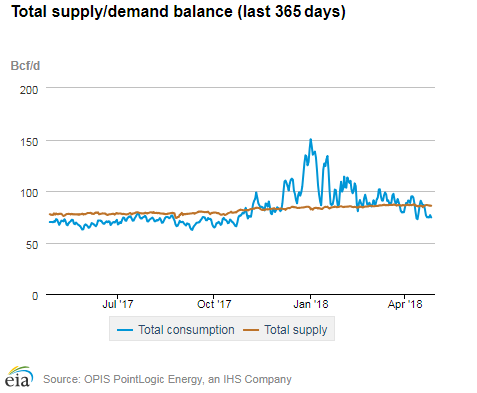
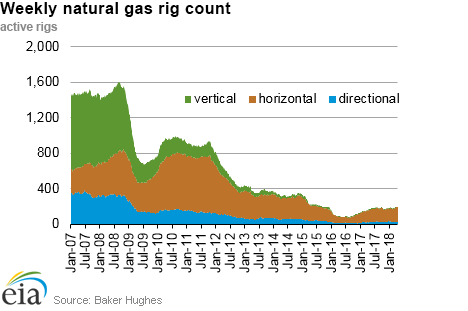
| Rigs | |||
|---|---|---|---|
Tue, April 17, 2018 |
Change from |
||
last week |
last year |
||
| Oil rigs | 820 |
0.6% |
19.2% |
| Natural gas rigs | 192 |
0.0% |
15.0% |
| Note: Excludes any miscellaneous rigs | |||
| Rig numbers by type | |||
|---|---|---|---|
Tue, April 17, 2018 |
Change from |
||
last week |
last year |
||
| Vertical | 54 |
-1.8% |
-31.6% |
| Horizontal | 889 |
0.7% |
23.8% |
| Directional | 70 |
0.0% |
16.7% |
| Source: Baker Hughes Inc. | |||
| Working gas in underground storage | ||||
|---|---|---|---|---|
Stocks billion cubic feet (Bcf) |
||||
| Region | 2018-04-20 |
2018-04-13 |
change |
|
| East | 205 |
207 |
-2 |
|
| Midwest | 211 |
228 |
-17 |
|
| Mountain | 84 |
83 |
1 |
|
| Pacific | 177 |
175 |
2 |
|
| South Central | 604 |
606 |
-2 |
|
| Total | 1,281 |
1,299 |
-18 |
|
| Source: U.S. Energy Information Administration | ||||
| Working gas in underground storage | |||||
|---|---|---|---|---|---|
Historical comparisons |
|||||
Year ago (4/20/17) |
5-year average (2013-2017) |
||||
| Region | Stocks (Bcf) |
% change |
Stocks (Bcf) |
% change |
|
| East | 299 |
-31.4 |
304 |
-32.6 |
|
| Midwest | 502 |
-58.0 |
368 |
-42.7 |
|
| Mountain | 148 |
-43.2 |
124 |
-32.3 |
|
| Pacific | 227 |
-22.0 |
233 |
-24.0 |
|
| South Central | 1,002 |
-39.7 |
779 |
-22.5 |
|
| Total | 2,178 |
-41.2 |
1,808 |
-29.1 |
|
| Source: U.S. Energy Information Administration | |||||
| Temperature – heating & cooling degree days (week ending Apr 19) | ||||||||
|---|---|---|---|---|---|---|---|---|
HDD deviation from: |
CDD deviation from: |
|||||||
| Region | HDD Current |
normal |
last year |
CDD Current |
normal |
last year |
||
| New England | 166 |
34 |
77 |
0 |
0 |
0 |
||
| Middle Atlantic | 137 |
24 |
70 |
0 |
0 |
-2 |
||
| E N Central | 170 |
53 |
119 |
0 |
0 |
-3 |
||
| W N Central | 185 |
77 |
129 |
0 |
-1 |
-6 |
||
| South Atlantic | 59 |
3 |
40 |
16 |
1 |
-14 |
||
| E S Central | 70 |
21 |
64 |
0 |
-5 |
-27 |
||
| W S Central | 43 |
21 |
41 |
12 |
-9 |
-34 |
||
| Mountain | 122 |
11 |
54 |
3 |
-5 |
-8 |
||
| Pacific | 88 |
23 |
26 |
0 |
-3 |
0 |
||
| United States | 120 |
32 |
72 |
5 |
-2 |
-10 |
||
|
Note: HDD = heating degree day; CDD = cooling degree day Source: National Oceanic and Atmospheric Administration | ||||||||
Average temperature (°F)
7-Day Mean ending Apr 19, 2018
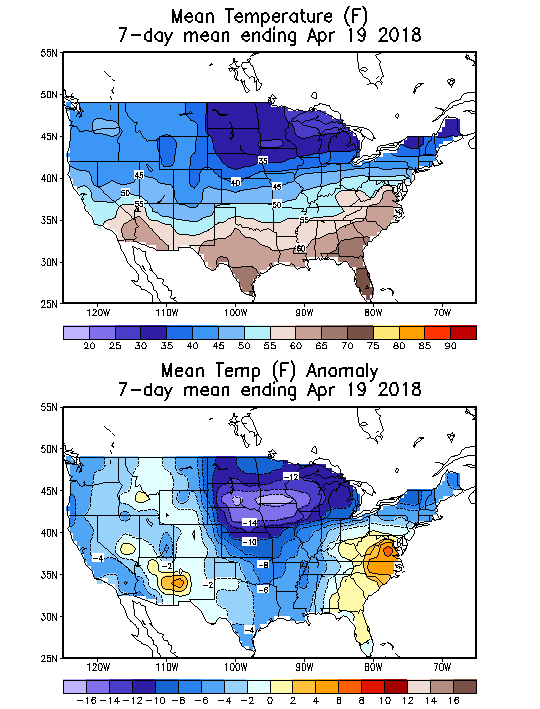
Source: NOAA National Weather Service
Deviation between average and normal (°F)
7-Day Mean ending Apr 19, 2018

Source: NOAA National Weather Service

